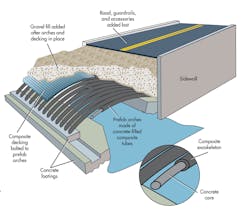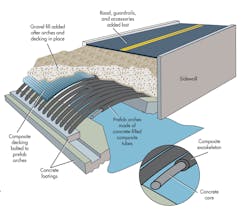Rethinking the Bridge
Bridges in the U. S. are not aging gracefully. The Federal Highway Administration estimates there are over 45,000 structurally deficient or obsolete bridges in the National Highway System, plus another 248,000 deficient bridges on smaller roads. To cut the cost of replacing many of those bridges, engineers at Advanced Infrastructure Technologies, Orono, Maine, have developed a hybrid concrete-composite bridge that also saves time and raw materials.
The key features of the bridge design are composite tubes that form structural arches. The flexible hollow tubes are first curved and shaped into the correct geometry for a specific bridge, then infused with proprietary resins that harden the tubes into that shape. The lightweight arches are easily trucked to the work site where they are manually placed over the creek or valley. There’s no need for heavy equipment.
Both ends are set in concrete footings. Fiber-reinforced-plastic panels are bolted over the tubes, which are then filled with concrete. The composite tubes eliminate the need for rebar or steel reinforcements, so there are no corrosion risks. They also do away with the need to build wooden forms to shape poured concrete pilings or supports, a process that can take up to two months. The tubes also protect the concrete from the environment so it won’t spall over time. Once the concrete cures, the arch is covered with gravel and fill and the roadway put down. Total construction time can be as little as two weeks.
Currently, composite tubes have been used on single-span bridges up to 75-ft long (bridges under 75 ft make up 57% of the nation’s bridges) and multispan bridges up to 800-ft long. Several AIT bridges have been erected and they all saved time, money, materials, and the end result were aesthetically pleasing bridges that should last 100 years.

